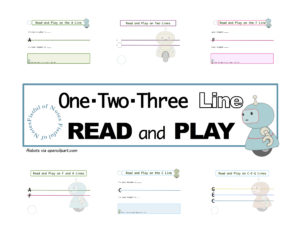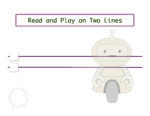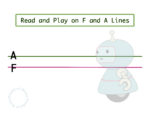Not Exactly Pre-Reading: 1-2-3 Line Read & Play
 With the beginning of the school year looming, the teachers I am mentoring are again full of questions about how to best help their beginning readers—especially those who look at the score as though it had lobsters crawling out of it. I myself recall answering, “Fly spot?” when my teacher asked me the name of a particularly pesky ledger line.
With the beginning of the school year looming, the teachers I am mentoring are again full of questions about how to best help their beginning readers—especially those who look at the score as though it had lobsters crawling out of it. I myself recall answering, “Fly spot?” when my teacher asked me the name of a particularly pesky ledger line.
My problem was that I didn’t understand the underlying system of the staff. I was taught using the Middle C method and memorized locations on the staff and on the piano a few at a time while remaining blissfully unaware of how the Grand Staff actually worked. Since I need to see the forest and I like to understand how things relate, it made remembering notation cumbersome to say the least.
After a while, I realized that all I had to do was count up and down, forward or backward and I could figure out anything without having to flip back and forth, remember a saying, or answer fly spot. Intervals? Well, I didn’t learn about intervals until college. Of course, they would have made learning to read even easier.
So, how do I help my early readers succeed? I start small, really small. We start with one line. I choose the name of the line. We identify the upper and lower neighbors (2nds if you want to introduce the term at that point). Then, I put removable stickers all on the line and the student plays the (very boring) one note melody. Next, I move one to a neighbor and we identify it. Then the student plays the new melody. I move another and that new melody is played. The student moves another and plays again. Sometimes the student makes a melody and I have to play it. We change the name of the line and play again.
I send the student home with instructions to change several notes and play their melody daily (plus some extra stickers). To eliminate confusion, I give students a separate sheet for each different line note I want them to work on. I might give them 2 or 3 sheets per week if they are doing well. It doesn’t matter which letter names you use because every note is a line note at some point on the Grand Staff. Matching actual locations to notes isn’t really necessary until you have 5 lines and spaces.
Once students are really great at one line reading, we move on to 2 lines and then 3. After that, 5 lines is a breeze but if there are setbacks we go
 back to fewer lines for a week or so. One, two, and three line reading also works very well in pairs or groups. Students love to try to trick another student and in so doing solidify what they themselves know. I had to make a rule that only 2 notes (sometimes only 1) can be changed per turn in order that everyone would be successful.
back to fewer lines for a week or so. One, two, and three line reading also works very well in pairs or groups. Students love to try to trick another student and in so doing solidify what they themselves know. I had to make a rule that only 2 notes (sometimes only 1) can be changed per turn in order that everyone would be successful.
This activity isn’t exactly what we think of as pre-reading. That usually involves note names written in note heads or note heads moving vertically with no staff. Often the next thing in a book is treble then bass staff reading, a few notes at a time. One Line Reading is more of a transition from traditional pre-reading to full staff reading. It is an interactive, compositional game and students are drawn in to learning without realizing it. I’ve also had success using a modified form of this game with adults who are struggling with reading.
This summer I created some fun robot themed ‘not exactly pre-reading’ sheets for you and your students. You can print them and use removable stickers, upload them to a tablet and draw on them, or stick them to a cookie sheet and use magnets for notes. 1-2-3 Line Read and Play sheets are available from my Fistful of Notes Store as a single packet and in two different bundles. Please enjoy and let me know about the creative ways you use 1-2-3 Line Read and Play.


